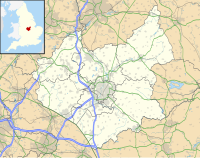Groby Castle
| Groby Castle | |
|---|---|
| Groby | |

Plan of Groby Castle (prior to building of the A50 across its northern earthworks)
|
|
|
Location in Leicestershire
|
|
| Coordinates |
52°39′50″N 1°13′36″W / 52.6640°N 1.2267°WCoordinates: 52°39′50″N 1°13′36″W / 52.6640°N 1.2267°W grid reference SK52390764 |
Groby Castle is situated in the large village of Groby to the north-west of the city of Leicester.
After the Norman Conquest, the area came into the possession of Hugh de Grantmesnil. Groby was one of 67 manors Grantmesnil held in Leicestershire according to the Domesday Book. The Victoria County History for Leicestershire suggests that Grantmesnil founded Groby Castle, as does the English Heritage Archive. However, medieval historian R. Allen Brown suggests a foundation date in the third quarter of the 12th century by the Earl of Leicester. This figure was accepted by Professor Leonard Cantor and David Cathcart King. Excavations in the 1960s demonstrated that the motte, an artificial mound, was built around a stone tower.
Along with Leicester, and Brackley, Groby was one of three castles belonging to the earl that were destroyed on the orders of Henry II after the Revolt of 1173–1174 led by his son, Prince Henry. In the 13th century a stone manor house was founded on the site. Antiquarian William Burton noted in the early 17th century that Groby Castle "was utterly ruinated and gone and only the mounts, rampires and trenches were to be seen".
A fragment of one wall remains, together with earthworks consisting of a large mound of earth at the rear of the present manor house known as Groby Old Hall. Part of the site is occupied by the church. In 1962 and 1963 excavations were carried out at Groby Castle in preparation for the construction of the A50 road nearby. The road, which runs past the north-east of the motte, destroyed some of the castle's outworks. In April 2010, archaeological television programme Time Team undertook excavations at the castle. Groby Castle is a Scheduled Monument, which means it is a "nationally important" historic building and archaeological site which has been given protection against unauthorised change.
...
Wikipedia

